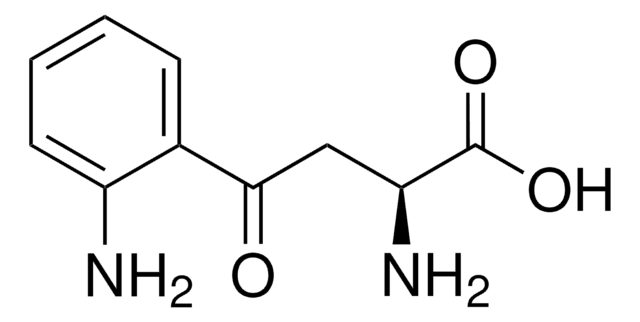Key Documents
SML0096
Cinnabarinic Acid
≥98% (HPLC)
Synonim(y):
2-amino-3-oxo-3H-phenoxazine-1,9-dicarboxylic acid, Cinnabaric acid
About This Item
Polecane produkty
Poziom jakości
Próba
≥98% (HPLC)
Postać
powder
warunki przechowywania
desiccated
kolor
red to very dark red
rozpuszczalność
DMSO: ≥4 mg/mL
temp. przechowywania
2-8°C
ciąg SMILES
NC1=C(C(O)=O)C2=Nc3c(OC2=CC1=O)cccc3C(O)=O
InChI
1S/C14H8N2O6/c15-10-6(17)4-8-12(9(10)14(20)21)16-11-5(13(18)19)2-1-3-7(11)22-8/h1-4H,15H2,(H,18,19)(H,20,21)
Klucz InChI
FSBKJYLVDRVPTK-UHFFFAOYSA-N
Zastosowanie
Działania biochem./fizjol.
Cinnabarinic acid (CA) connects between initiation of the kynurenine pathway and immune tolerance that is used to prevent neuroinflammation.
Cechy i korzyści
Kod klasy składowania
11 - Combustible Solids
Klasa zagrożenia wodnego (WGK)
WGK 3
Temperatura zapłonu (°F)
Not applicable
Temperatura zapłonu (°C)
Not applicable
Certyfikaty analizy (CoA)
Poszukaj Certyfikaty analizy (CoA), wpisując numer partii/serii produktów. Numery serii i partii można znaleźć na etykiecie produktu po słowach „seria” lub „partia”.
Masz już ten produkt?
Dokumenty związane z niedawno zakupionymi produktami zostały zamieszczone w Bibliotece dokumentów.
Nasz zespół naukowców ma doświadczenie we wszystkich obszarach badań, w tym w naukach przyrodniczych, materiałoznawstwie, syntezie chemicznej, chromatografii, analityce i wielu innych dziedzinach.
Skontaktuj się z zespołem ds. pomocy technicznej







